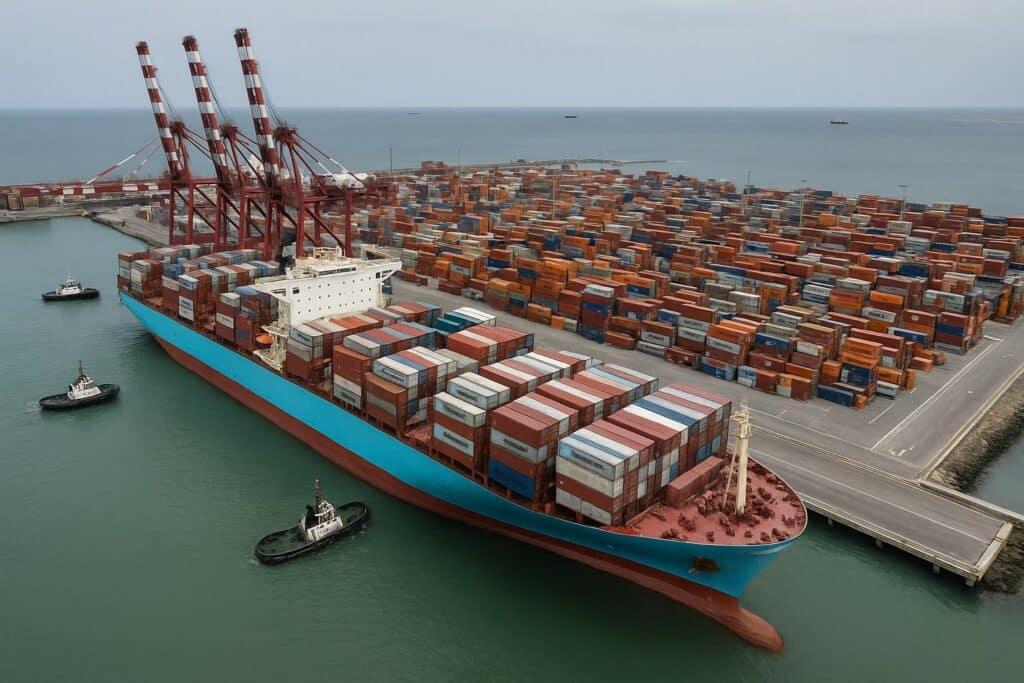Strategic milestone for Pointe-Noire’s blue economy
When the 368-metre Maersk Halifax eased alongside the quays of Congo Terminal after its voyage from Cape Town, a discrete yet significant page of Central African maritime history was turned. Never before had the Autonomous Port of Pointe-Noire received a container vessel capable of carrying up to 15 690 twenty-foot equivalent units. For the management team, the manoeuvre was more than a feat of seamanship; it was a confirmation that years of targeted capital expenditure are aligning with the new geometry of global liner services.
“The arrival of the Maersk Halifax is a collective source of pride and a demonstration of our ability to adapt to the evolution of international maritime traffic,” noted Christel Anga, Execution Manager at Congo Terminal, as mooring lines were fastened. In the current environment, where shipping companies recalibrate their rotations around ever larger ships, being able to handle a post-Panamax titan positions Pointe-Noire as an indispensable node between the Atlantic, the Gulf of Guinea and the hinterland corridors of the Congo Basin.
€350 million invested since 2009: an incremental transformation
Behind this operational success lies a financial trajectory that began in 2009, the year Africa Global Logistics (AGL) won the concession for the container terminal. More than €350 million have since been channelled into quay reinforcement, yard resurfacing, shore-power readiness, gantry crane modernisation and—crucially—people. Each line in the investment ledger reveals a long-term commitment whose cumulative effect is now tangible in the form of extra berthing drafts and faster turnaround times.
Management insists that capital decisions were guided by a doctrine of gradual scalability. The objective was not to rush towards gigantism, but to prepare the ecosystem—customs clearance, trucking, rail connections—for bigger volumes without disrupting existing traffic. The docking of a 15 000-plus-TEU vessel offers empirical proof that the doctrine is working.
Human capital: training as the silent backbone
State-of-the-art quay cranes are only as efficient as the operators behind their joysticks. AGL’s subsidiary has therefore tethered hardware acquisition to an ambitious up-skilling programme. Since the beginning of the concession, cohorts of technicians, safety supervisors and planners have undergone continuous training calibrated to international standards. The successful handling of the Maersk Halifax, executed without incident and within schedule, testifies to the maturity reached by these teams.
Dockers interviewed on the apron underline a renewed sense of professional confidence. “Working a vessel of this size used to be theoretical for us; today it is part of our routine horizon,” one senior signalman observed, reflecting a culture shift that may ripple across other Congolese logistics platforms.
East Mole expansion: sizing for 20 000-TEU era
Even as celebratory whistles echoed across the harbour, construction crews were busy on the East Mole, a future platform designed to berth vessels exceeding 20 000 TEU. Once operational in 2027, the extension is expected to recalibrate capacity metrics yet again, pushing throughput and bringing ancillary services—from cold-chain warehousing to ship supply—into a higher value bracket.
Company sources underscore that the project follows the same public-private partnership model that underpinned earlier investments, thereby limiting pressure on public finances while ensuring that technological standards remain world-class. For the local manufacturing and agribusiness community, the prospect of direct calls by mega-carriers translates into reduced trans-shipment costs and greater predictability in export schedules.
Key takeaways for investors and policymakers
For foreign direct investors scanning the Gulf of Guinea, the ability to berth the Maersk Halifax sends a signal of logistical reliability. Container lines routing via Pointe-Noire can now deploy economies of scale comparable to those offered by longer-established hubs. From a regulatory standpoint, the episode also illustrates the dividends of concession models that align operator incentives with the state’s ambition to nurture a diversified economy.
Legal specialists note that the framework governing port operations preserved the balance between sovereign oversight and managerial autonomy, allowing for agile decision-making on capital expenditure while safeguarding public interests such as safety and environmental compliance.
Economic and legal spotlight
In purely economic terms, the enlarged handling capability should widen the country’s trade bandwidth, cushioning the economy against commodity price swings by facilitating non-oil exports. Concurrently, the modernisation may stimulate competition within the shipping consortiums that serve Central Africa, potentially translating into lower freight rates for importers of consumer goods.
On the legal front, the precedent strengthens the case for transparent, long-duration concessions in critical infrastructure. The performance benchmarks embedded in the 2009 agreement—throughput targets, maintenance schedules, and workforce localisation ratios—have so far been met, according to internal audits. These results could inform future contract renegotiations or new tenders in related sectors.

